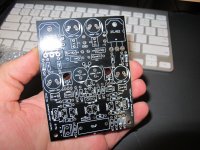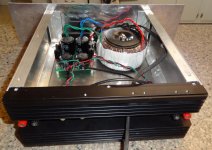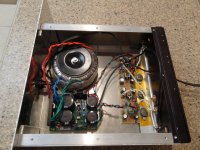Thanks for the feedback. Though it wasn't intentionally set up for alternative CCS arrangements it is nice to see how easily is can be adapted without hacking up the board.
I'll be curious to get you listening impressions once you have them hooked up.
Listening impressions will have to wait a few weeks - busy schedule ahead. But I expect it to sound nice. I built a BJT version on perfboard and I liked the sound a lot, but fried one channel by accidentally feeding it a high voltage on the input. I tried swapping out a few parts but got tired of that and decided to hop on with your nice boards instead, as they fit my casework.
Sheldon
If it's OK with you guys I'm going to hang loose before I install it in a case and watch what kind of changes you make. 😀
Of course you are welcome to hang out here. Feel free to get involved and throw out ideas and suggestions, I'm looking to evolve the idea.
I don't think there is going to be any major revision to the existing board, but as Sheldon has demonstrated it adapts to the 1Q+LED type of CCS very easily. Wether this is better or not I can't say, but it offers an alternative for anyone so inclined to try.
I am still cooking up a new one but want it to be pretty well complete before show and tell.
I don't think there is going to be any major revision to the existing board, but as Sheldon has demonstrated it adapts to the 1Q+LED type of CCS very easily. Wether this is better or not I can't say, but it offers an alternative for anyone so inclined to try.
I am still cooking up a new one but want it to be pretty well complete before show and tell.
Would the power supply boards for the DX amps Juan Vargas sells be a good match for this amp? 1board for 2 channels?
I have only had a cursory look at the DX power supply and I don't see any reason why it wouldn't work just fine. I think still4given has a DX supply, maybe ask him if he has paired it with the VSSA.
I paired my
DX supply with a SKA GB150. It works very nice. I'm not sure how it compares to the Mr Evil cap multiplier. It has a bigger footprint but it uses all BJT transistors which is a plus to me.
DX supply with a SKA GB150. It works very nice. I'm not sure how it compares to the Mr Evil cap multiplier. It has a bigger footprint but it uses all BJT transistors which is a plus to me.
By special request...
No changes to the layout, just ordered in black solder mask and 2oz copper. Cost ended up somewhat higher with these options, just high enough for the Canadian government to want to wet their beaks too with duty 🙁.
Pretty slick looking too me though 😎.
I should mention that these are essentially spoken for unless the prospective buyers back out or reduce quantity requested. That said should I do a proper group buy on the existing design? Any opinions?
No changes to the layout, just ordered in black solder mask and 2oz copper. Cost ended up somewhat higher with these options, just high enough for the Canadian government to want to wet their beaks too with duty 🙁.
Pretty slick looking too me though 😎.
I should mention that these are essentially spoken for unless the prospective buyers back out or reduce quantity requested. That said should I do a proper group buy on the existing design? Any opinions?
Attachments
Last edited:
Any opinions?
I wouldn't mind if it were wider ... well, don't mind me 😛
I wouldn't mind if it were wider ... well, don't mind me 😛
I actually chose the dimensions because I was being cheap with presensitized boards - I could do a stereo pair on one 6"x4" board - and just stuck with that. The narrow board has the advantage of being able to go multi-channel on one heat sink, which was another consideration. Future plans will hopefully keep the same overall dimensions but will move some parts around.
Hi,
Me likey!!! Beautiful boards indeed.
I saw that you said you can put two boards on one heatsink. Could you please let me know the size of this heatsink? The reason I ask is that I want to build two of these for mono blocks for bi-amping my speakers. Therefore, i would put two channels in each box in mono mode... I want to know the size of the heatsink necessary.
Thank you.
Bertrand
Me likey!!! Beautiful boards indeed.
I saw that you said you can put two boards on one heatsink. Could you please let me know the size of this heatsink? The reason I ask is that I want to build two of these for mono blocks for bi-amping my speakers. Therefore, i would put two channels in each box in mono mode... I want to know the size of the heatsink necessary.
Thank you.
Bertrand
Bertrand,
The boards are intended to be mounted vertically, though as a DIY'er you can certainly do whatever you feel is appropriate.
With that in mind something like a 3U case would accommodate the height with room to spare vertically. Provide at least 4" of heat sink width per module, more if it is reasonable. Choose a heat sink offering fins at least 1" deep. Basically the lower the ˚C/W rating of the heat sink the better but these don't kick off crazy heat so there comes a point of limited return on the investment in hardware. A 3U 300mm (~12") deep chassis should be enough for six channels and a very comfortable home for four modules.
Hope that gives a little direction.
The boards are intended to be mounted vertically, though as a DIY'er you can certainly do whatever you feel is appropriate.
With that in mind something like a 3U case would accommodate the height with room to spare vertically. Provide at least 4" of heat sink width per module, more if it is reasonable. Choose a heat sink offering fins at least 1" deep. Basically the lower the ˚C/W rating of the heat sink the better but these don't kick off crazy heat so there comes a point of limited return on the investment in hardware. A 3U 300mm (~12") deep chassis should be enough for six channels and a very comfortable home for four modules.
Hope that gives a little direction.
Hi,
Me likey!!! Beautiful boards indeed.
I saw that you said you can put two boards on one heatsink. Could you please let me know the size of this heatsink? The reason I ask is that I want to build two of these for mono blocks for bi-amping my speakers. Therefore, i would put two channels in each box in mono mode... I want to know the size of the heatsink necessary.
Thank you.
Bertrand
Hi Jason, you are thinking about a new GB for these boards?. I would like to get a couple of more boards if it is ok.
Quan
Quan
Hi Jason, you are thinking about a new GB for these boards?. I would like to get a couple of more boards if it is ok.
Quan
If there is continued demand I would do so. I would consider getting a larger quantity next time to make it more worth while.
Hi Jason,
It does help. The way I was thinking of building this is having two boards on one heatsink with the heat sink pointing up (fins up). So, if I understand correctly, I can put two boards per heatsink and arrange it that they have each a 4" breathing room.
I am curious to know what builders are using as components to populate the boards. I will be using PRP resistors but am curious to know the brand of caps that is used and preferred. I was thinking of using Elnas or Nichicons.
What, in your opinion, is the best out there? Open question to all!
Thanks.
Bertrand
It does help. The way I was thinking of building this is having two boards on one heatsink with the heat sink pointing up (fins up). So, if I understand correctly, I can put two boards per heatsink and arrange it that they have each a 4" breathing room.
I am curious to know what builders are using as components to populate the boards. I will be using PRP resistors but am curious to know the brand of caps that is used and preferred. I was thinking of using Elnas or Nichicons.
What, in your opinion, is the best out there? Open question to all!
Thanks.
Bertrand
Bertrand, I updated post #1 to list the dimensions for future reference but to answer to you they are 3"x4".
As for component choices it runs as deep as religion for some. A can of worms I don't want to open. I will however state I have been using products from Nichicon, Wima, Vishay, Dale and Bourns for most of the 'critical' areas. I have built these literally out of the junk box and with new el-cheapo parts and they all sound just fine. The basic design seems pretty tolerant of component choice.
I'd encourage vertical orientation for the heat sink fins for best coolong by convection, but given a generous enough area you may get away with the fins pionting up.
As for component choices it runs as deep as religion for some. A can of worms I don't want to open. I will however state I have been using products from Nichicon, Wima, Vishay, Dale and Bourns for most of the 'critical' areas. I have built these literally out of the junk box and with new el-cheapo parts and they all sound just fine. The basic design seems pretty tolerant of component choice.
I'd encourage vertical orientation for the heat sink fins for best coolong by convection, but given a generous enough area you may get away with the fins pionting up.
On My first VSSA, Jason's TO-3 design, I mounted both boards on one heatsink that is 4 1/2' x 11" with 1" fins running horizontally and it does just fine. I'm not saying this is the best orientation, just letting you know that these amps don't run all that hot. BTW that amp may still be my favorite of the 4 VSSA I've built.Bertrand, I updated post #1 to list the dimensions for future reference but to answer to you they are 3"x4".
As for component choices it runs as deep as religion for some. A can of worms I don't want to open. I will however state I have been using products from Nichicon, Wima, Vishay, Dale and Bourns for most of the 'critical' areas. I have built these literally out of the junk box and with new el-cheapo parts and they all sound just fine. The basic design seems pretty tolerant of component choice.
I'd encourage vertical orientation for the heat sink fins for best coolong by convection, but given a generous enough area you may get away with the fins pionting up.
Attachments
- Status
- Not open for further replies.
- Home
- Amplifiers
- Solid State
- VSSA Through-Hole Version by Jason



